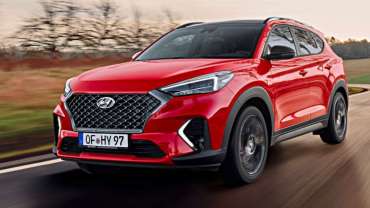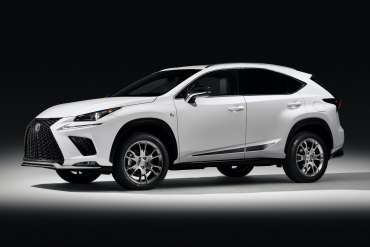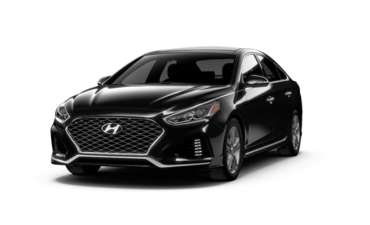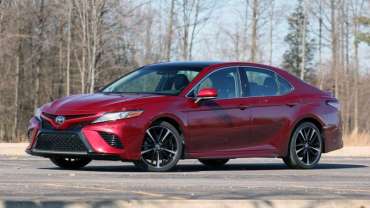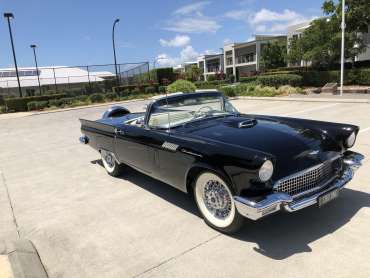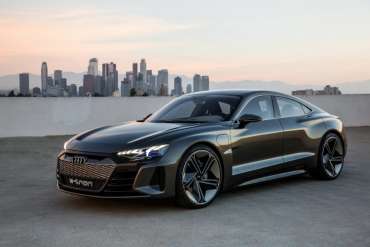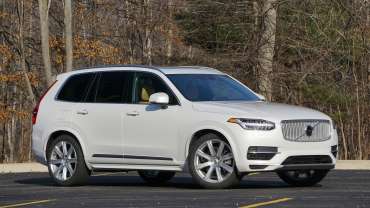
World Car Blog
2022 Hyundai Tucson Redesign
Redesign for its 2022 Hyundai Tucson is preparing, multiple prototypes have been spotted as well.
Also is paying off, Hyundai’s move to rework its notoriously car heavy lineup with a batch of new, redesigned or freshened crossovers. The brand has seen record sales performance this year among its crossovers, which for first time in June, topped the 30,000-a-month mark.
Already is at a late stage of development the prototype, as it's wearing the lights and wheels that will end up on the production model. Sales will start in the second half of 2021, making it a 2022 model, we suspect.
We can already see that the new Tucson will be a very handsome vehicle but there's still a lot of camouflage gear. Hyundai previewed the design with the Vision T concept car unveiled in Los Angeles Auto Show during November.
Using principles from Hyundai's Sensuous Sportiness design language introduced with last year's Le Fil Rouge concept, the design has been crafted. The new compact crossover SUV will be slightly bigger than the model it replaces, especially at the rear section, it also looks like.
A new electrified option could finally be offered but there's no word on the power trains. A sporty Tucson N with as much as 340 horsepower being developed, we've also heard. For 2020, the current Tucson is offered with two power train options. The base option is a 2.0-liter inline-4 delivering 161 hp and above this is a 2.4-liter inline-4 with 181 hp.
Like most automakers, Hyundai is investing big in its SUV portfolio, as well. The top of the range for 2021, just has been added the new Palisade, while at the same time a new Venue has been added at the bottom the range, which brings Hyundai's SUV family to six members.
2021 Lexus NX
Toyota’s luxury department started working on the new generation Lexus NX, according to our insiders. Which will include a range of changes inside, outside, under the skin, and beneath the hood, the interesting crossover is reportedly getting a total redesign. Most probably at the 2020 New York Auto Show, the 2021 Lexus NX should be introduced in the first half of next year.
2021 Lexus NX Gets Lighter Bones
We don’t have any solid information regarding the redesigned model at the moment, the new SUV will ride on a different platform that will cut some weight and enable utilizing of new technologies, though unofficially. The 2021 NX crossover will add a few extra inches in length that will definitely have a positive influence on the car’s cargo room, which is among the biggest issues of the current model.
The next generation Lexus NX will most definitely receive a revolutionary makeover, surprisingly. Isn’t going to have anything in common with its predecessor, says for that the luxury compact crossover. The new model will get new cues based on the automaker’s impressive Lexus LF-1 Limitless concept that debuted Monday at the 2018 North American International Auto Show in Detroit, instead. The sleek and futuristic design will be toned down a little bit, but the details such as the spindle grille and sweeping roofline will definitely come on board, of course. Inside, the two-row SUV will keep legroom as spacious as earlier, though, cargo space should be increased, as we said earlier.
Lexus will not forget to load the SUV with the latest technological achievements, including the new infotainment and entertainment, as well as more standard driver assistance features and maybe even some kind of self-driving kit, of course. The list of standard driving features include a rearview camera, lane keep assist, lane departure warning, adaptive cruise control, automatic high beams, and a pre-collision system with pedestrian detection, but when the 2021 Lexus NX arrives, the offer will be expanded to a birds-eye-view camera system, parking sensors with automatic braking, blind spot monitoring, rear cross traffic alert and more, so far.
Under The Hood Of The 2021 Lexus NX
A quite simple engine choice, offers, today’s model. You can only pick a 235-hp turbo engine and a six-speed auto gearbox that shifts the power to either front or all four wheels, in other words. Probably offer more than that, the successor will most. The 2021 Lexus NX is going to have several new options including, plug-in hybrid and EV drivetrains, namely, if we have the right information. We have nothing about them, though we are pretty sure that the crossover which relies on internal consumption technology will sport an updated turbo option with around 30 extra ponies. We highly doubt in that scenario, the latest rumors hint a possibility of a new 3.5-liter twin-turbo V6 under the hood.
2022 Hyundai Sonata Redesign
The new 2022 Hyundai Sonata Redesing will have cool interior, curved and modern from one side, and also sterile and a bit antiseptic from the other side.
Hyundai's new global head of design SangYup Lee create a smooth looking car. He make combination of the latest Aston Martin styling, take some details from Audi A7 and Mercedes-Benz CLS.
Design is the key enabler that should take Hyundai to the next level.
2022 Sonata will have a 1.7 inches in overall length along with nearly an inch in width. Height drops by 1.2 inches and wheelbase increases by 1.4. In the front, 0.8 inches of overhang is lopped off and added to the 1.2-inch increase in rear overhang. These are significant inches, but also reflect the category's increase in size over the intervening years. The 2022 Hyundai Sonata is now easily within an inch of contemporary competitors as Honda Accord and Toyota Camry.
The 2022 Sonata Redesign will have a sporty proportions with millimetric precision, in Hyundai put lots of thought and effort into the lines and open spaces.
Sonata is safety car?
Regarding construction, new 2022 Hyundai Sontata will have the metal in the body is all steel; no aluminum here, despite potential weight savings, because one of Hyundai's corporate cousins (alongside Hyundai shipping, construction and banking/finance) is Hyundai Steel. Other reason is to improve crash performances.
Hyundai designers spent lots of time thinking about how the needs of design and safety can work together. Consider the Sonata's sleek front end, which is 1.4 inches lower than the previous generation. Nearly all modern cars have hoods that terminate in a bumper containing the grille, more often than not with an obvious/ugly shut line. What distinguishes the Sonata is how the steel (not composite) hood flows all the way to the front of the car ending in an edge above the grille.
The main reason for such a low and sexy hood to meet pedestrian impact standards meant the engine needed to be pushed down and back. Then there are the sculpted steel front fenders and dazzling headlight array.
The most striking element is the strip of bright metal that starts at the base of the headlights and curves around the passenger compartment, before returning to the A-pillar. It's a nearly unbroken strip of chrome so thoughtfully considered, you wonder why there is a break in it at all. Then the daytime running lights switch on, and the genius is revealed. As you approach the top of the headlight from the base of the windshield, the strip of chrome reflected light gradually gives way to LED lumens. This metal-to-light gradient is achieved by a series of tiny laser-etched holes in the chrome plating that covers the translucent strip of plastic. The holes increase in size toward the headlight cluster, until all the chrome is gone and only light remains.
An aggressive mix of steel, composite and polycarbonate is used for the dramatic rear.
2022 Hyundai Sonata engine
Sontata will offer red and gray car option. The red car equipped with a 1.6-liter turbo-four "Smartstream" engine, and a gray car powered by Hyundai's new Atkinson-cycle 2.5-liter four-cylinder, also dubbed Smartstream.
Side by side, the 2022 Sonata 1.6T and 2.5 models reveal some hints about what we'll see in the U.S.-bound production cars. At least two different front and rear bumpers will be on offer. From the Le Fil Rouge concept comes the "parametric jewel" grille seen on the Sonata 1.6T in red. This spicier, sportier version has slightly more aggressive vents in its bumpers, as well as sideskirts, and 19-inch wheels. The gray Sonata has a more conservative chrome grille and 18-inch wheels, which match its entry-level aspirations. Biermann hints that there will definitely be something sportier on the way.
Market projection for family sedan
According Hyundai's own research confirms that the midsize family sedan market is shrinking fast; the segment hit a high in 2013 with sales of 2.4 million, but is quickly losing steam. Hyundai has a projection showing sales could hit only 1 million units in 2023.
2023 Toyota Camry Redesign, Release date, Price, Engine
Toyota is introducing the new technology on its 2023 Camry as a stand-alone option on most trim levels. Looking to join the ranks of midsize sedan makers with an all-wheel drive option. on models built from 1988 to 1991, was the last time Toyota offered AWD on a Camry. Also Toyota will make all-wheel drive available on its full-size 2021 Avalon.
AWD will be only available on versions equipped with the normally aspirated 2.5-liter 4-cylinder engine, while Toyota is one of the few makes still offering a V6 in the midsize class. Although on certain trim levels with dual exhaust, that number is bumped to 205 horses, mated to an 8-speed automatic transmission, the powertrain delivers 202 horsepower. Distinguishing characteristic of these models will be an AWD badge on the rear deck is the only. All AWD models come with the Cold-Weather Package, which has heated seats and mirrors on the LE and heated steering wheel on the XLE and XSE, heated seats, mirrors and steering wheel on the SE.
Built for the U.S. market
The all-wheel drive system was developed specifically for the U.S. market and all models will be assembled at its Georgetown, Ky, plant, Toyota said. Because both vehicles share the same Toyota New Generation Architecture, the all-wheel drive setup is adapted from the Toyota RAV4 and is use is made possible.
A Dynamic Torque Control system that sends most of the output to the front axle, features the 2023 Camry AWD. Than if slip is detected, is sent to the rear wheels, up to 50-percent of the torque. The electromagnetically controlled coupling on the front of the rear-drive axle disengages the prop shaft to help maximum fuel economy, when all-wheel drive isn’t needed.
Design changes
Putting its curb weight roughly in line with V6 models is because adding the all-wheel drive system and a new rear axle adds about 165 pounds to the 2023 Camry. To be redesigned had the floor pan, and the system requires the use of an electronic parking brake as well as a saddle-style fuel tank instead of the standard flat tank to accommodate the rear axle, as well.
The changes to the vehicle hasn’t affected the seating position or compromised usable interior volume, Toyota says. The company says the Camry AWD models, other than offering better traction, provide the same ride and handling characteristics of the front-drive models, also.
AWD lineup and pricing
When it goes on sale next spring, the all-wheel drive option will be offered on Camry LE, XLE, SE and XSE trim levels. Though typically AWD runs anywhere from $1,200 to $2,000 as an option, but pricing will be announced closer to its launch. The front-drive 2023 Toyota Camry LE starts at $24,840, the SE at $26,040, the XLE at $29,325 and the XSE at $29,875. Exclude $955 delivery on all price.
Compete with the Nissan Altima, which offers AWD as an option, and the Subaru Legacy, which has all-wheel drive as a standard feature, will the 2023 Toyota Camry AWD models.
Ford Thunderbird (1955–1957)
A true classic by any standards. The original T-Bird was a response to Chevy's Corvette, and oozes '50s diners and drive-ins style from every angle.
Ford Thunderbird dominated on the American market within a few decades. To the casual observer, the Thunderbird is an icon: a sports car with a 50-year history that’s the rolling embodiment of nostalgia. But like most legends, the true story is a lot more complicated.
Interesting fact is that T-Bird isn’t even really a sports car.
Purchase Thunderbird
If you would like to buy Ford Thunderbird, the price is from $ 25,000 up to $ 90,000.
How is born Thunderbird?
Henry Ford II was falling hard for European sports cars. In 1952, Enzo Ferrari had gifted him a Ferrari 212 Barchetta, and at that year’s Paris Motor Show, he took designer George Walker to task for not having something similar in the works. After the show, Walker called his team in Detroit, and told them to have a presentation ready when the men returned from Paris.
The sports car project was quickly given the green light by Ford, and took on a new sense of urgency in January 1953, when Chevrolet released the Corvette. But Chevy’s sports car was heavy and underpowered, laden with quality control issues (fiberglass construction was still in its infancy), and saddled with a wheezy inline-six and two-speed automatic transmission. This gave Ford an invaluable chance to learn from Chevy’s mistakes. As the Corvette struggled, the company learned what customers wanted — and most importantly, what they didn’t.
Ford’s car would be steel-bodied. It would be a two-seater, but would be roomier and more refined than the Corvette. It would ride on its own unique chassis, but would share much of its trim work and interior with other Ford products. And most importantly, it would have the company’s new Y-Block V8 and available manual transmission, two things Chevy didn’t offer. Nearly a year after the Corvette made its debut, the Thunderbird bowed at the Detroit Auto Show to rave reviews.
There was a basic problem: It wasn’t a sports car. The Thunderbird was too plush, too heavy, and too sluggish to compete with the likes of MG, Triumph, Porsche, or Jaguar. Unlike Chevy, which shot itself in the foot by billing the Corvette as a sports car, Ford marketed the Thunderbird as a “personal car” instead, appealing not to weekend racers, but to well-to-do buyers who wanted something fun to drive without sacrificing comfort. Purists who expected a world-beater were disappointed. The American public, however, was not.
Ford had only planned to build 10,000 T-Birds for the 1955 model year. Within the first 10 days after its debut in Detroit, it had over 3,500 orders. It would end up selling over 16,000 before the year was out. And that was no small task; at over $4,000 fully-loaded, the Thunderbird could be twice as expensive as a base-model Ford coupe, and as much as the far more capable Jaguar XK140.
Thunderbird sales were a huge success for Ford. Available with either a 292 or 312 cubic inch V8, the T-Bird could be had with a manual or automatic transmission, power seats, a removable hardtop, and a telescoping steering wheel — all luxury amenities that customers loved. Another 15,600 cars sold for 1956. In 1957, the number jumped even higher to 21,300.
The second-generation “Square Bird” would find nearly 200,000 buyers over the next three years.
2023 Audi A4 Electric Sedan, Release date, Price, Interior, Exterior
According to a new report, Audi’s bringing an A4-size electric sedan to the market in the next four years. To the growing e-tron electric lineup, it will be the latest addition.
Audi announce at Geneva, that there will be (electric) SUVs and low-floor sporty cars such as the e-tron GT, which is our ‘halo’ car. As well there will be an e-tron GT in the [A4- sized] segment. Right now, they working on this.
So, the upcoming model will share a chassis with the larger, A6-size e-tron GT. That’s being developed jointly between Audi and Porsche, it’s the PPE all-electric architecture. Audi is working on one of a handful of new electric platforms. The modified MLB that underpins the e-tron and e-tron Sportback and the MEB VW Group chassis that sits under the Q4 e-tron. The report says, the A4-size electric is due to be introduced in 2023. That will follow the e-tron GT and the Q4 e-tron, with the latter expected to launch in late 2020. year. Sooner than you might think, Audi CEO Bram Schot expects the electric Q4 to sell in significant volumes, catching up with the Q3.
Audi is kicking its electrification plans into high gear with the launch of the E-Tron due to be followed later this year by its more stylish sibling, the E-Tron Sportback, better late than never. In the second half of next year, these two fully electric crossovers will be joined by the Tesla Model S-rivaling E-Tron GT, in the pipeline for a late 2020 launch with a road-going Q4 E-Tron.
Audi will have a total of 12 pure electric models on sale, with an assortment of crossovers, sedans, wagons, and hatchbacks in the offing, by the middle of the next decade. The aforementioned E-Tron GT will be joined by a smaller sedan similar in size with the A4 to go up against the Tesla Model 3, speaking of sedans.
The man behind Ingolstadt’s latest design language confirmed that development of the smaller electric sedan has already started, without going into too many details. The new zero-emissions model will ride on the same PPE platform as the E-Tron GT, which by the way will have approximately the same size as the A6 Sedan, too.
If you’re not familiar with “PPE,” it stands for “Premium Platform Electric” and represents a joint effort between Porsche and Audi. The end of 2021, the first PPE-based models are scheduled to hit the market towards. PPE will be used on a variety of models “covering the high-volume B through D segments, in Audi’s case.
The A4-sized EV is earmarked for a 2023 release, according to the British magazine. It could mean we will see the production version as early as 2022, if that’s correct. It’s that there will be a concept car to preview the real thing, much like it was the case with the E-Tron GT, if history has taught us anything.
2022 Volvo XC90
Volvo announced plans to put the next-generation XC90 into production at its new U.S. plant in 2022 and now the company has disclosed some preliminary details about the large SUV. Volvo’s Senior Vice President, Henrik Green, revealed the third generation of the premium SUV will be smart enough to offer level 4 autonomous driving technology to haul “sleeping passengers” from point A to point B on some roadways, in an interview with The Car Connection.
On the standard model that won’t be possible, as you will need to tick the box called -Highway Assist- and doing so is going to set you back - four figures. To be implemented in future production models, Volvo has been testing more advanced self-driving tech for quite some time and it has teamed up with Uber to work on a more complex system.
Considering that earlier this year an XC90 was involved in a fatal crash in Tempe, Arizona, it hasn’t been smooth sailing for Volvo. Parts maker Aptiv that provided the SUV’s radar and camera said the tech was not at fault as the vehicle’s standard collision avoidance was not active at the time of the incident, that being said.
Green specified the new Highway Assist will rely on cloud-based information rather than on the vehicle-to-infrastructure communications systems, getting back to the 2022 XC90. Volvo will be in contact with regulators in the U.S. to get the mandatory stamp of approval for its advanced self-driving tech.
A level 4 autonomous driving system implies, to better understand what, it refers to a car that can complete an entire trip without any human intervention. Has the usual driver controls such as the steering wheel and pedals for the situations in which a human has to take control of the vehicle, still. Level 5 is the ultimate goal: no steering wheel, no pedals, with the car doing all the work, as well.
It’s worth mentioning the 2022 Volvo XC90 will not have a full level 4 autonomous driving system since Highway Assist will only work on certain mapped roads, such as highways as the name of the tech implies, as a final note.

